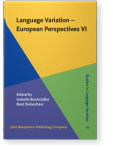Dynamics, variation and the brain
German dialects offer an unparalleled data situation for carrying out fine-grained research on language change. On the basis of empirical data, phonetic-cum-phonological change can be traced back over 100 years in time and space. Which factors play a role in triggering the different types of sound change can be determined on the basis of the available data. It will be demonstrated how neurolinguistic methods can be applied to study speaker-listener constellations between language varieties in contact with one another. Linguistic stability, word for word phonological change and the rapid change of phonemes as a whole are accompanied by differing physiological processes in the brain for the speaker and the listener.
Keywords: linguistic dynamics, sound change, phoneme clash, contact varieties, chain shift, neurolinguistic processes, centralisation, synchronization, Bavarian, Swabian, Mosel Franconian
Article outline
- 1.Introduction
- 2.First type: Sound change proceeds one word at a time
- 2.1Data and explanations
- 2.2… and the brain?
- 3.Second type: Sound change affects phonemes as a whole
- 3.1Data and explanations
- 3.2… and the brain?
- 4.Conclusion
-
Acknowledgements
-
Notes
-
References
References (24)
References
Bentin, Shlomo, Y. Mouchetant-Rostaing, M. H. Giard, J. F. Echallier, and J. Pernier. 1999. “ERP Manifestation of Processing Printed Words at Different Psycholinguistic Levels: Time Course and Scalp Distribution.” Journal of Cognitive Neuroscience 11: 235–260. 

Domahs, Ulrike, Richard Wiese, Ina Bornkessel-Schlesewsky, and Matthias Schlesewsky. 2008. “The Processing of German Word Stress: Evidence for the Prosodic Hierarchy.” Phonology 25, 1–36. 

Domahs, Ulrike, Wolfgang Kehrein, Johannes Knaus, Richard Wiese, and Matthias Schlesewsky. 2009. “Event-Related Potentials Reflecting the Processing of Phonological Constraint Violations.” Language and Speech 52 (4), 415–435. 

Drenda, Georg. 2000. Zentralisierung. Probleme der Vokalentwicklung im Westmitteldeutschen. Stuttgart: Steiner. (Mainzer Studien zur Sprach- und Volksforschung 23).
Harnisch, Rüdiger. 2015. “Untersuchungen zur Sprachsituation im thüringisch-bayerischen Grenzgebiet (SPRiG).” In Regionale Variation des Deutschen. Projekte und Perspektiven, ed. by Roland Kehrein, Alfred Lameli, and Stefan Rabanus, 219–240. Berlin/Boston: de Gruyter. 

Herrgen, Joachim, and Jürgen Erich Schmidt. 1986. “Zentralisierung. Eine phonetisch-phonologische Untersuchung zu Konstanz und Wandel vokalischer Systeme.” In Beiträge zur Dialektologie am Mittelrhein, ed. by Günter Bellmann, 56–100. Stuttgart: Steiner. (Mainzer Studien zur Sprach- und Volksforschung 10).
König, Werner (ed). 1997–2009. Sprachatlas von Bayerisch-Schwaben. Heidelberg: Universitätsverlag C. Winter. (Bayerischer Sprachatlas: Regionalteil 1).
Labov, William. 1994. Principles of Linguistic Change. Internal Factors. Oxford [ et al.]: Wiley-Blackwell.
Lanwermeyer, Manuela, Karen Henrich, Hanni Th. Schnell, Marie Josephine Rocholl, Alexander Werth, Joachim Herrgen, and Jürgen Erich Schmidt. 2016. “Dialect-related variation influences the phonological and lexical-semantic processing in sentences. ERP evidence from a cross-dialectal comprehension study.” Frontiers in Psychology 7: 739. 

Malkiel, Yakov. 1967. “Every Word Has a History of its Own.” Glossa. An International Journal of Linguistics 1: 137–149.
Mentz, Christian Michael. 2006. Zentralisierungsabbau im Moselfränkischen: Eine phonetisch-phonologische Studie zu einem sprachdynamischen Prozess. Master thesis. University of Marburg.
Murray, Robert W. 2010. “Language and Space: The Neogrammarian Tradition.” In Language and Space: Theories and Methods, ed. by Peter Auer, and Jürgen Erich Schmidt, 70–87. Berlin/New York: de Gruyter Mouton. (Handbooks of Linguistics and Communication Science 30.1).
Werth, Alexander, Karen Henrich, Manuela Lanwermeyer, Hanni Th. Schnell, Ulrike Domahs, Joachim Herrgen, Jürgen Erich Schmidt, and Marie Josephine Rocholl. Forthcoming. “The Interaction of Vowel Quantity and Tonal Cues in Cognitive Processing: An MMN-Study Concerning Dialectal and Standard Varieties.” In Empirical Approaches to the Phonological Structure of Words, ed. by Christiane Ulbrich, Alexander Werth, and Richard Wiese.
Rocholl, Marie Josephine. 2015. Ostmitteldeutsch – eine moderne Regionalsprache? Eine Untersuchung zu Konstanz und Wandel im thüringisch-obersächsischen Sprachraum. Hildesheim/Zürich/New York: Olms. (Deutsche Dialektgeographie 118).
Schmeller, Johann Andreas. 1821. Die Mundarten Bayerns grammatisch dargestellt. München: Thienemann.
Schmidt, Jürgen Erich. 2010a. “Language and Space: The Linguistic Dynamics Approach.” In Language and Space: Theories and methods, ed. by Peter Auer, and Jürgen Erich Schmidt, 201–225. Berlin/New York: de Gruyter Mouton. (Handbooks of Linguistics and Communication Science 30.1).
Schmidt, Jürgen Erich. 2010b. “Dynamic Linguistic Maps and Validation.” In Language and Space: Language Mapping, ed. by Alfred Lameli, Roland Kehrein, and Stefan Rabanus, 385–401. Berlin/New York: de Gruyter Mouton. (Handbooks of Linguistics and Communication Science 30.2). 

Schmidt, Jürgen Erich. 2015. “Historisches Westdeutsch und Hochdeutsch: Der Ein-Schritt-Wandel des Langvokalismus.” Sprachwissenschaft 40: 235–288.
Schmidt, Jürgen Erich, and Joachim Herrgen (eds). 2001–2009. Digitaler Wenker-Atlas (DiWA). In cooperation with Alfred Lameli, Tanja Giessler, Roland Kehrein, Alexandra Lenz, Karl-Heinz Müller, Jost Nickel, Christoph Purschke, and Stefan Rabanus. Marburg: Forschungszentrum Deutscher Sprachatlas. [[URL]].
Schmidt, Jürgen Erich, Joachim Herrgen, and Roland Kehrein (eds). 2008ff. Regionalsprache.de (REDE). In cooperation with Dennis Bock, Brigitte Ganswindt, Heiko Girnth, Simon Kasper, Roland Kehrein, Alfred Lameli, Slawomir Messner, Christoph Purschke, and Anna Wolańska. Marburg: Forschungszentrum Deutscher Sprachatlas. [[URL]].
Schmidt, Jürgen Erich, and Joachim Herrgen. 2011. Sprachdynamik: Eine Einführung in die moderne Regionalsprachenforschung. Berlin: Erich Schmidt Verlag. (Grundlagen der Germanistik 49).
Sendlmeier, Walter F., and Seebode, Julia. 2007. Formantkarten des deutschen Vokalsystems. URL: <[URL]>.
Thomé, Aloys. 1908. Untersuchungen zum Vokalismus der moselfränkischen Mundart von Kenn. PhD thesis. University of Bonn.
Wiesinger, Peter. 1982. “Die Reihenschrittheorie: Muster eines dialektologischen Beitrags zur Erklärung des Lautwandels.“ In Dialektologie. Ein Handbuch zur deutschen und allgemeinen Dialektforschung, ed. by Werner Besch et al., 144–151. Berlin/New York: de Gruyter. (Handbooks of Linguistics and Communication Science 1.1).
Cited by (1)
Cited by one other publication
Hinskens, Frans
2020.
The Expanding Universe of the Study of Sound Change. In
The Handbook of Historical Linguistics,
► pp. 5 ff.

This list is based on CrossRef data as of 16 july 2024. Please note that it may not be complete. Sources presented here have been supplied by the respective publishers.
Any errors therein should be reported to them.
